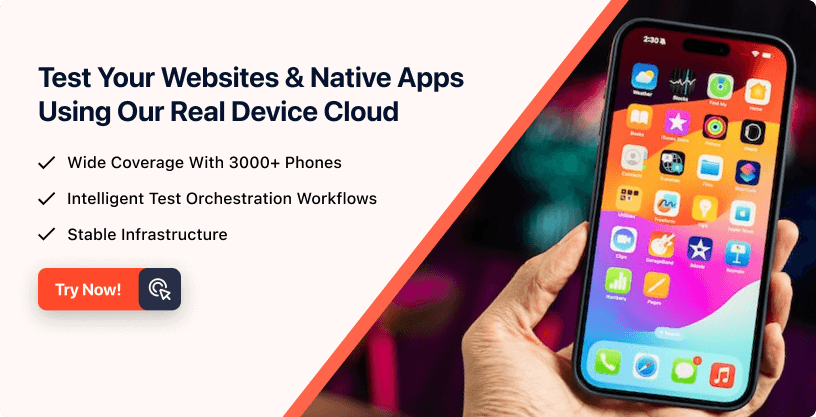- Automation
- Home
- /
- Learning Hub
- /
- Real-Time Testing: Best Practices Guide
- -
- May 19 2023
Real-Time Testing: Best Practices Guide
Learn the significance of real time testing, its types, best practices, and more. Ensure software quality and reliability by testing in real time.
OVERVIEW
Real time testing is a crucial part of the Software Development Life Cycle that involves testing software applications for their reliability and functionality in real time. This involves simulating the real-time environment or scenarios to verify the performance of the software application under various load conditions. Due to this, real time testing has become one of the major aspects of software testing. It has been popularized based on its ability to test the software application in its operational mode.
In this fast-growing software industry, organizations struggle to maintain the pace of software application development and its release. In this process, testing application quality, performance, and functionality is the priority phase which helps ensure end-user requirements are fulfilled. However, software testing is a vast domain, and software applications have to undergo various stages of testing that vary from functional to non-functional testing as per software application requirements.
In this Software Development Life Cycle, testing in real-time is like a boon that aims to deliver high-quality applications in a shorter time. This test requires it to be carried out throughout the software development process. It allows testers to identify and resolve the bugs early, which saves time and resources in the long run. Thus, it is easy to be compliant with industry standards and regulations.
What is Real Time Testing?
Real time testing involves validating the functionality and performance of software applications in the live environment. The primary purpose of real time testing is to lower the probability of the failure of software applications in a real time environment.
You can understand real time testing as a dynamic process that includes monitoring the software application in real time while being executed. Real time testing can be performed using automated, manual, and exploratory techniques. Such tests require specific tools and software testing methodologies that help QAs to simulate real-time scenarios like network latency, high traffic volumes, and system crashes.
This involves testing the capability of the software application to handle unexpected events and situations in real time environments. The testing in real-time principle is based on verifying the software application’s ability to respond correctly and promptly to external stimuli from various sources, such as the network, the user interface, or other connected systems. Thus, it works to ensure that software application functions optimally and consistently, even though it experiences high-volume data or network congestion.
Why is Real Time Testing important?
Real time testing is the main part of the Software Testing Life Cycle because it gives information on the functionality of the software application in real-world conditions. It helps ensure that the developed software application meets end-user requirements and guarantees performance.
With testing in real-time, you can identify errors or bugs that may occur during the operational or working mode of the software applications. This allows you to fix the software application's bugs before they impact the functionality of a software system.
Testing in real-time gives a broader perspective of the overall software applications. It helps you better understand how software applications function under different situations, allowing you to optimize them for better performance. Therefore, you need to perform real time testing as it helps lower the risk of software application failure and downtime.
Note : Run real-time tests across 3000+ environments. Try LambdaTest Now!
Real Time Testing Example
Suppose you are developing a mobile application that gives real-time weather updates to users. The application extracts data from different APIs, giving end-users weather information and alerts. To test this application in a real-time environment, you perform real time testing that involves various testing types. For example, you perform a functional test to ensure the application works correctly and gives accurate weather data to users. This consists of testing different scenarios, like when the user travels or has a weak Internet connection.
You can conduct performance testing to check the application's response time, resource utilization, and throughput. You can simulate diverse network connections like bandwidth to check how the application responds. It could involve testing the application with real users to check how they interact with the interface and how quickly they find the required information.
In this example, real time testing includes simulating real-world scenarios software applications may encounter, like poor network conditions, user interaction, etc. Hence, its primary purpose is to ensure that the application works optimally and consistently in such an environment and meets the user’s usability, timeliness, and accuracy requirements.
Where to Perform Real Time Testing?
Performing testing in real-time can be accomplished either on a local machine or in the cloud, each with its unique advantages and disadvantages.
Testing on a local machine allows for greater control over the testing environment. Teams can customize infrastructure and tools to meet their needs, resulting in faster testing cycles without network latency. However, more resources are needed to help scale up to larger scenarios.
Conversely, cloud-based testing offers virtually unlimited resources and scalability without hardware limitations. This method is also cost-effective since teams only pay for the resources they use.
Choosing between these two options depends on project-specific needs such as cost, control, and scalability. Cloud technology has revolutionized real time testing by providing increased flexibility compared to traditional methods. Cloud platforms offer customizable infrastructure and tools that can quickly scale up or down required for varying application loads.
With virtually unlimited resources available on demand through a pay-per-use model, cloud-based testing is particularly beneficial for resource-intensive testing requirements in real-time.
Performing real time testing in the cloud is effective for web and mobile application testing as it excludes the need for local test infrastructure. With cloud-based digital experience testing platforms like LambdaTest, you can simultaneously leverage real time testing on multiple browsers and devices. It offers both manual and automated testing approaches where you can perform real time testing on 3000+ browsers and devices and OS test your software applications.
Here are some key features of LambdaTest:
- It allows you to perform real-time cross-browser compatibility testing of software applications. With this, you can monitor the look of the software application on various browsers and devices in real time.
- It provides a wide range of Android and iOS mobile devices that enable you to test your software application on old and latest versions of browsers.
- While performing real time testing, testers interact with the developed software application as an end-user would. It allows checking for errors, bugs, and other issues which might affect user experience.
Catch up on the latest testing tutorials around Selenium automation, Cypress testing, and more. Subscribe to the LambdaTest YouTube Channel for quick updates.
How to Perform Real Time Testing using LambdaTest
Real time testing in LambdaTest can be performed on different desktop and mobile browsers, emulators, simulators, and real devices. Here are the steps explained below, which will help you to get started.
Real Time Testing on Desktop and Mobile Browsers
You can test websites and web apps in LambdaTest, which offers a manual testing approach through its real time testing features. Below are the steps to follow:
- Login to the LambdaTest account by registering for free.
- Select the Realtime Testing card from the modal box that popped up.
- You will be guided to the Real Time Browser Testing console.
- Select the test configuration of your choice, like browser VERSION, OS, and RESOLUTION. Enter the test URL and hit on START.
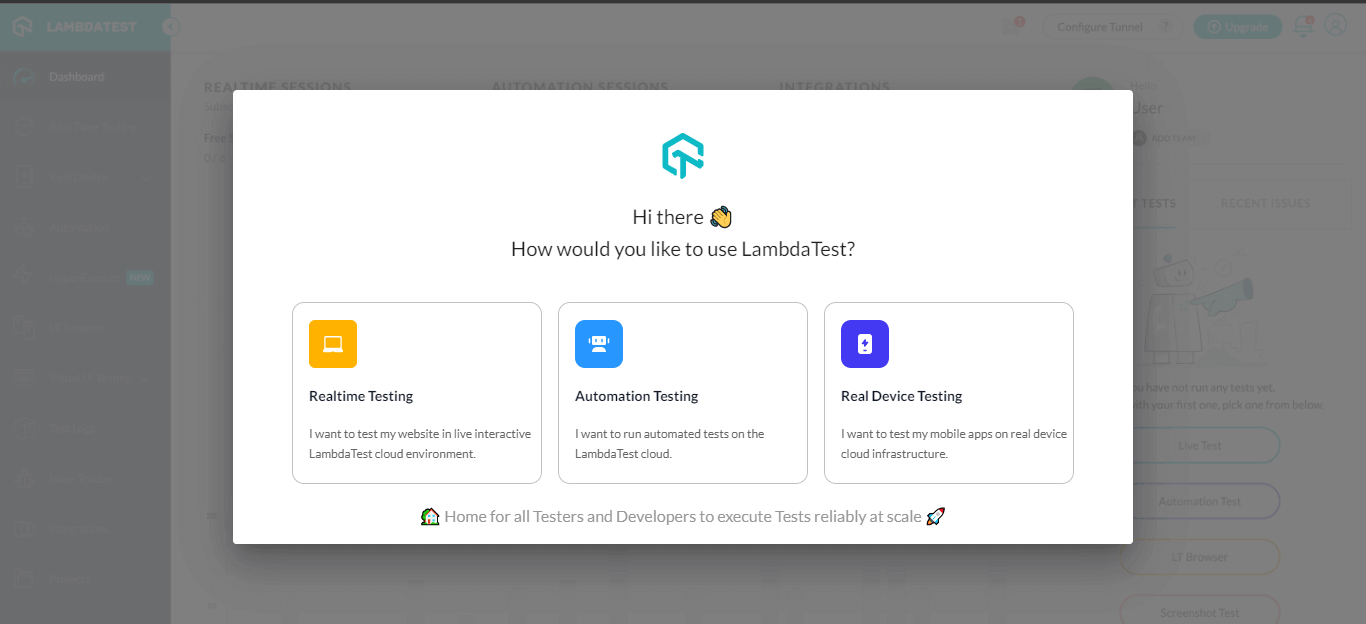
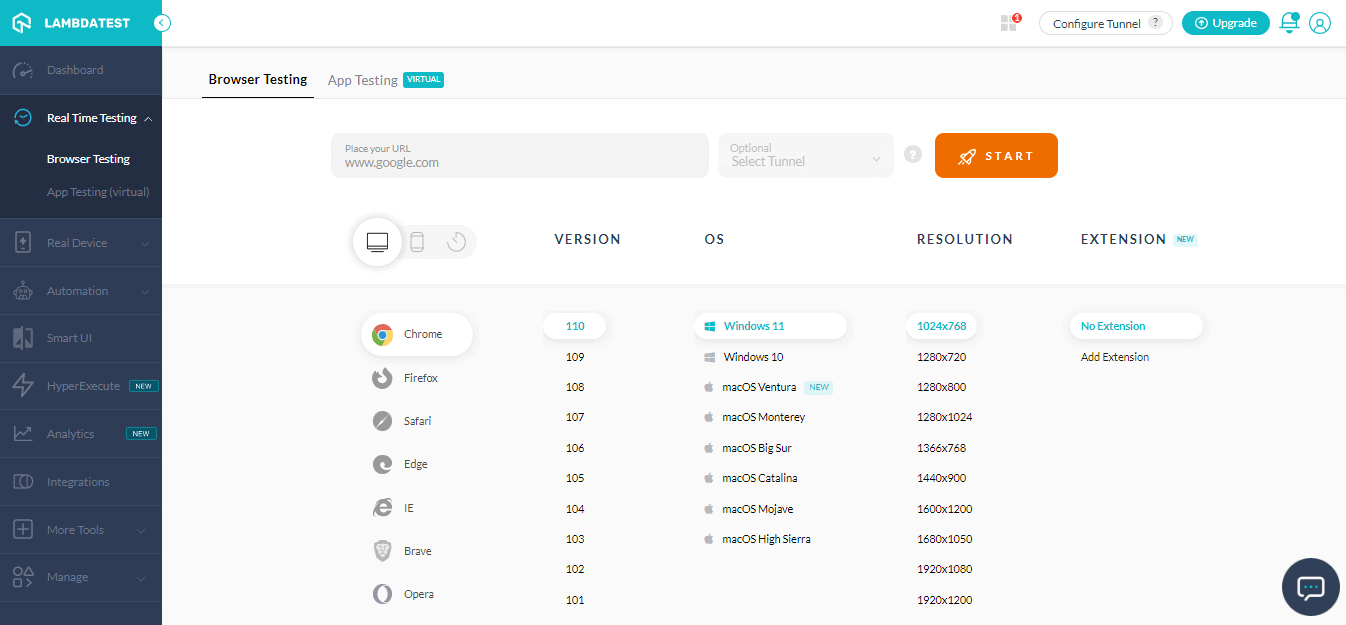
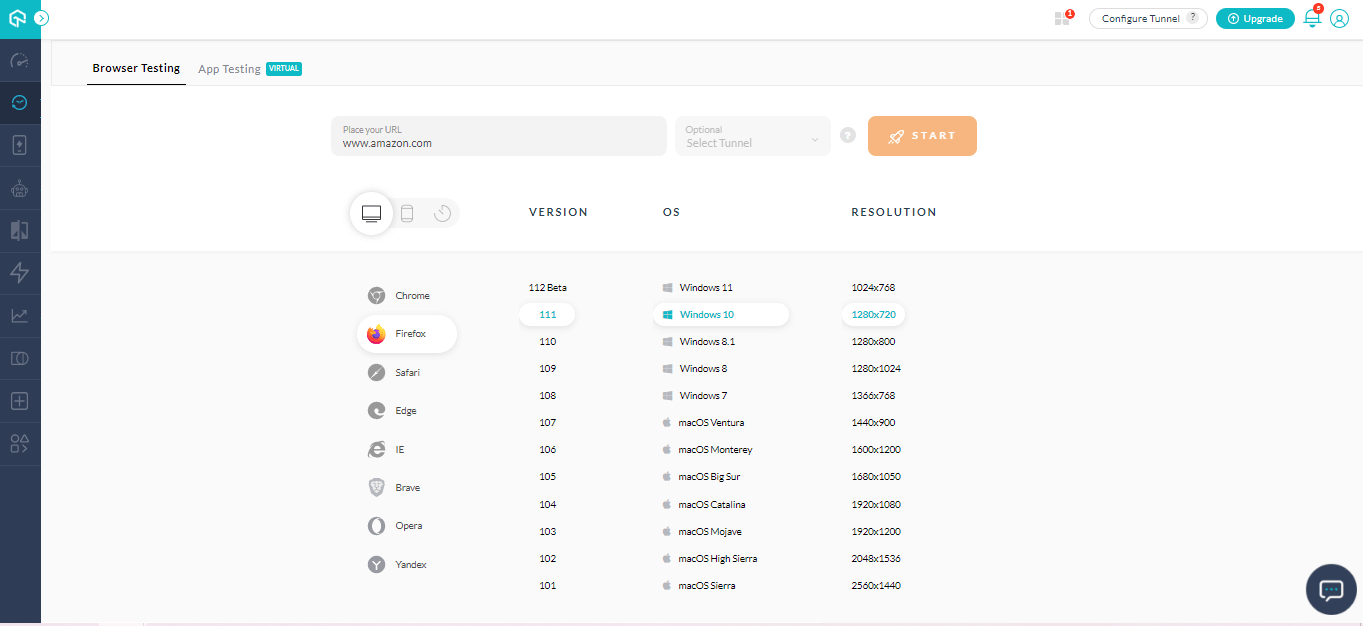
A cloud-based real operating system will be launched based on the selected test configuration. Now you can perform real time testing.
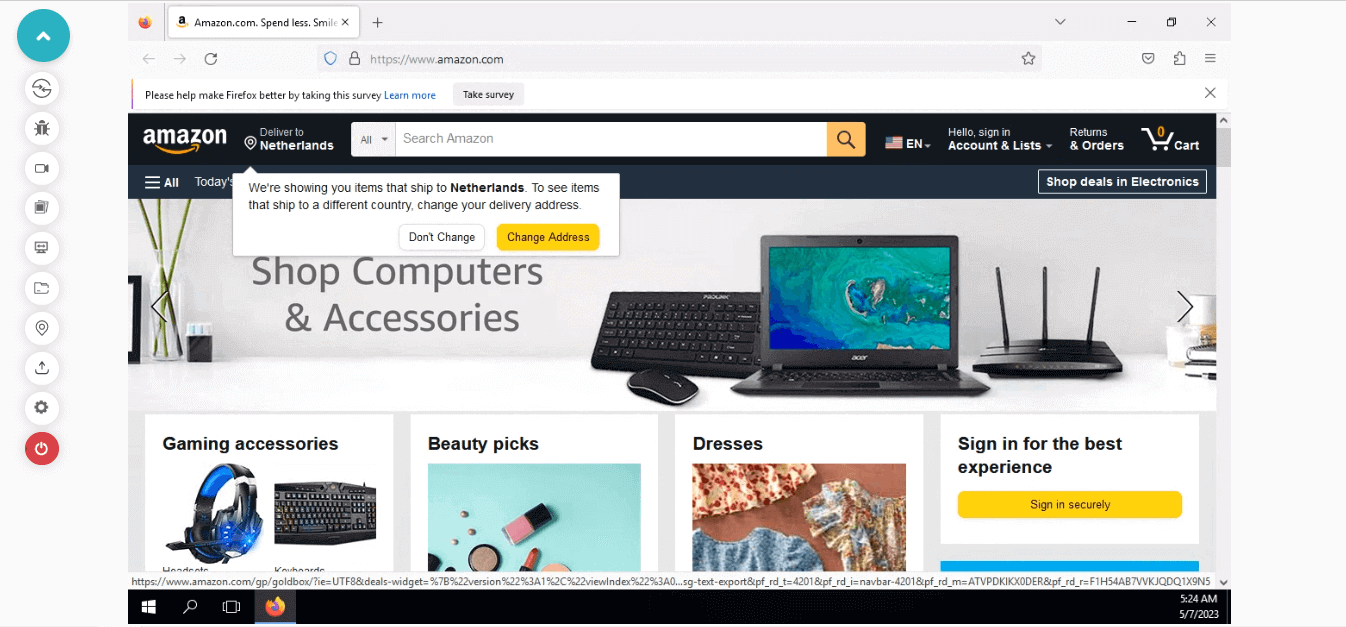
Note : To get started, please follow this guide: Real Time Browser Testing.
Real Time Testing on Emulators & Simulators
LambdaTest offers you to perform real time testing on emulators and simulators to test mobile applications. Here are the steps to follow:
- Log in to the LambdaTest account and choose the Realtime Testing card, as explained above.
- Navigate to the App Testing option.
- Select Android or iOS. Upload mobile apps (.apk or public URL) by choosing test configuration (device BRAND and DEVICE/OS). Then click START.

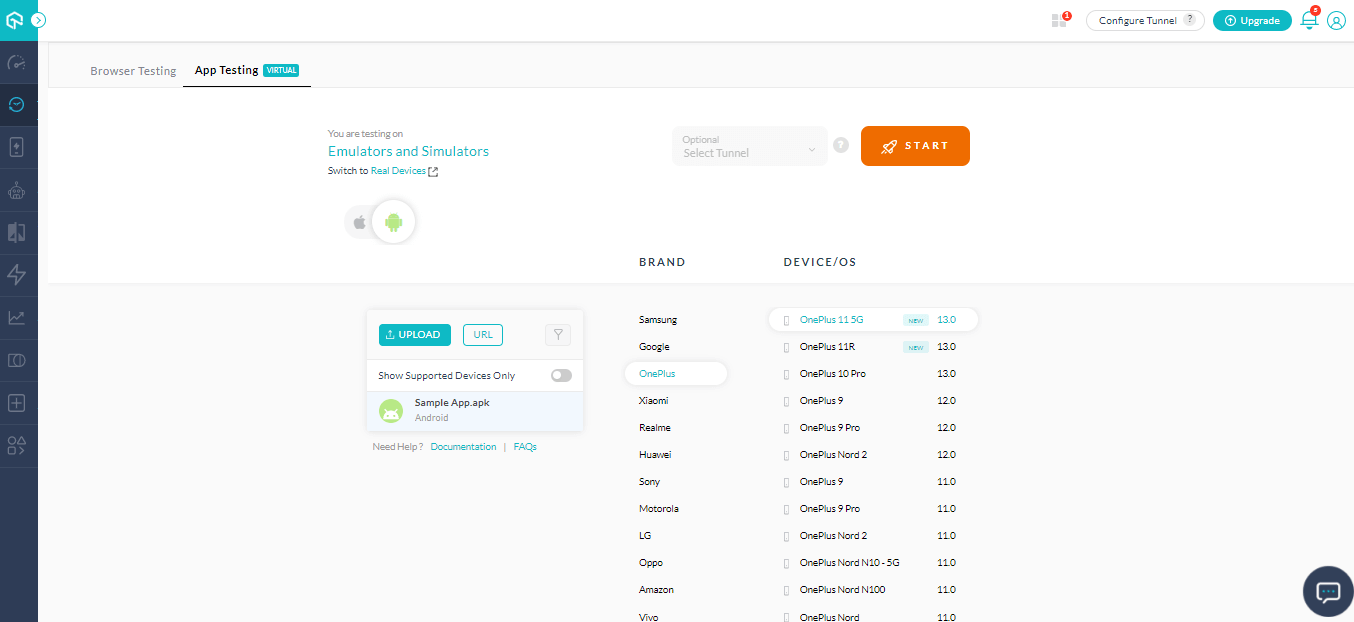
It will launch an emulator or simulator where you can run real-time tests.
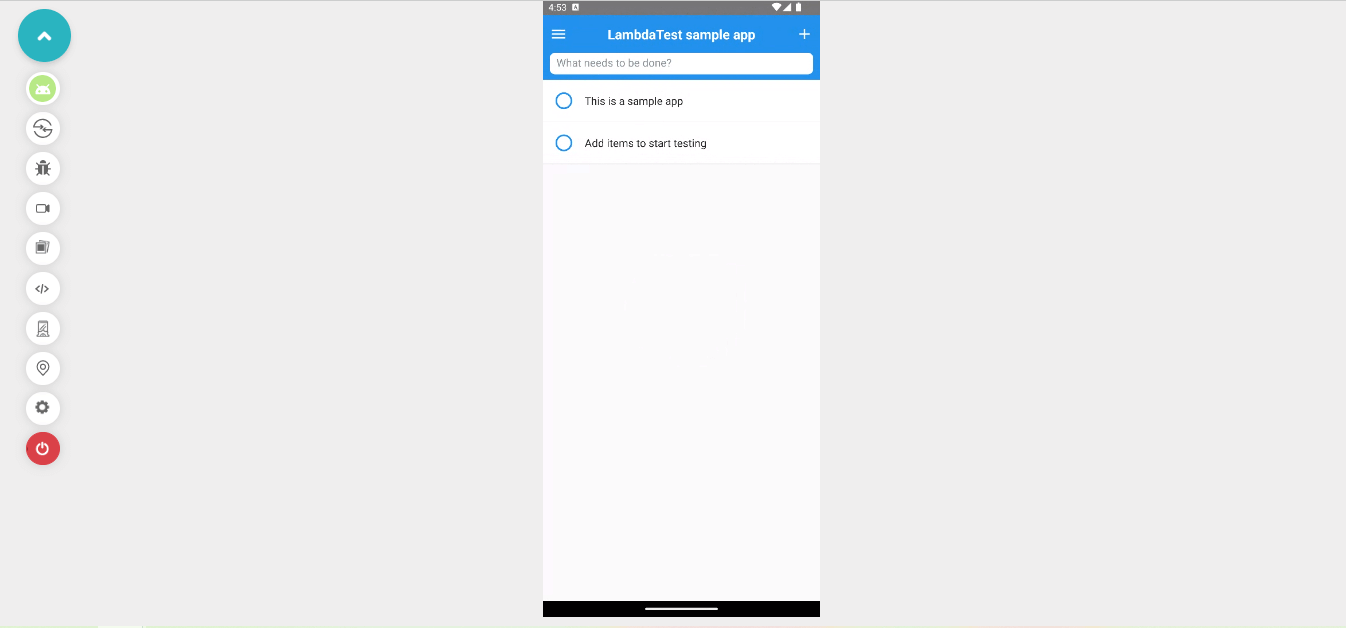
Real Time Testing on Real Devices
On a similar note, you can also perform real time testing on real devices with LambdaTest real device cloud. This allows users to test their web applications on various real devices, browsers, and operating systems. Below are the steps for the same.
- Log in to the LambdaTest account, as explained above.
- Choose the Real Device Testing card from the modal box, and you will be navigated to the Real Device App test console.
- You can either perform App Testing or Browser Testing on Real devices. Let’s choose the App Testing option to perform real-time app testing on real devices.
- Select Android or iOS. Upload mobile apps (.apk or public URL) by choosing test configuration (device BRAND and DEVICE/OS). Then click START.
- You will get a cloud-based real device to perform real-time application testing.
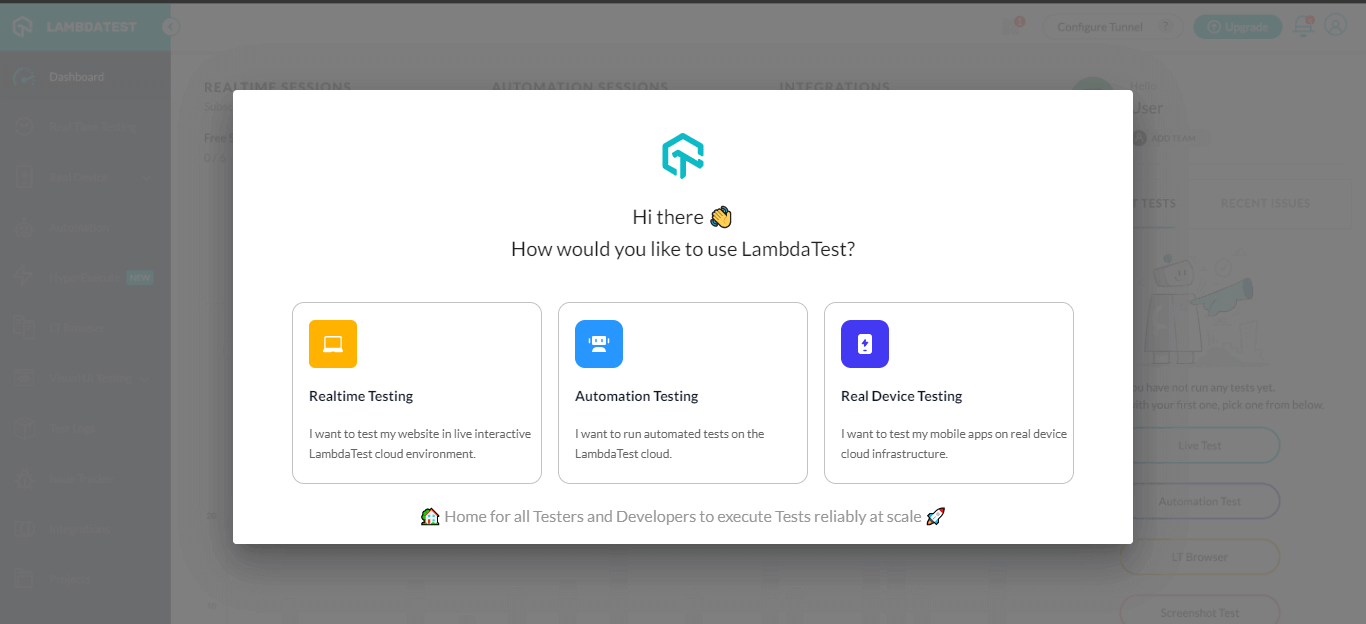
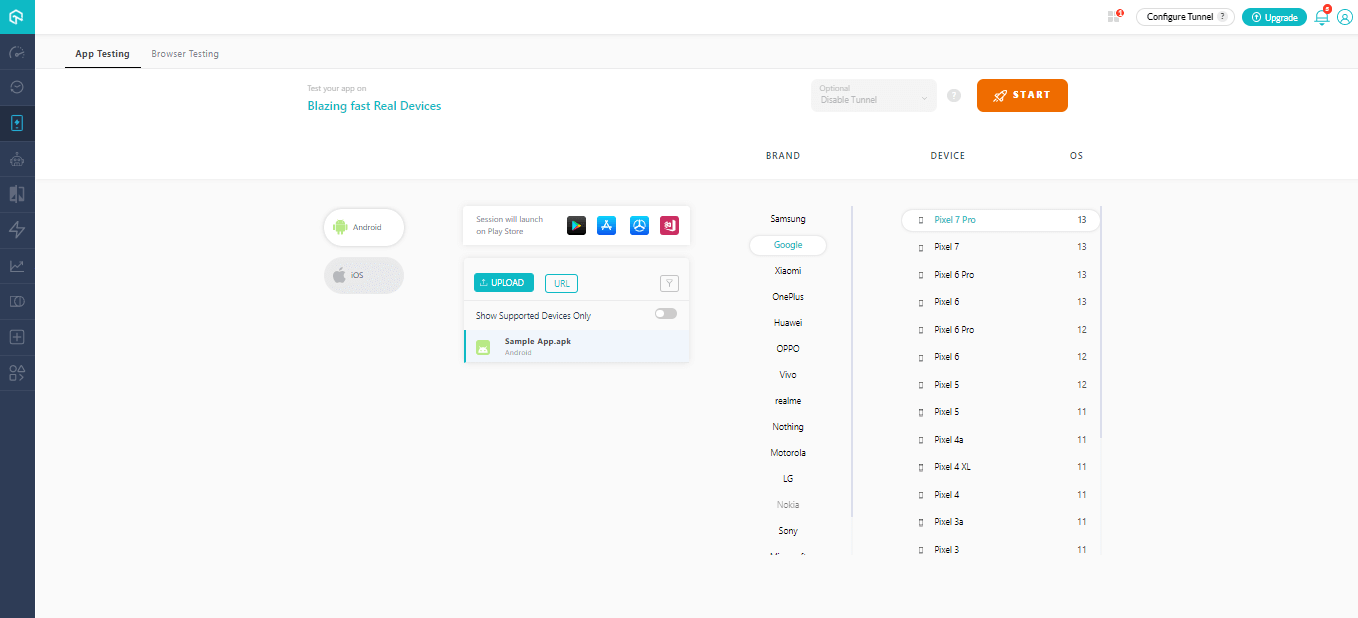
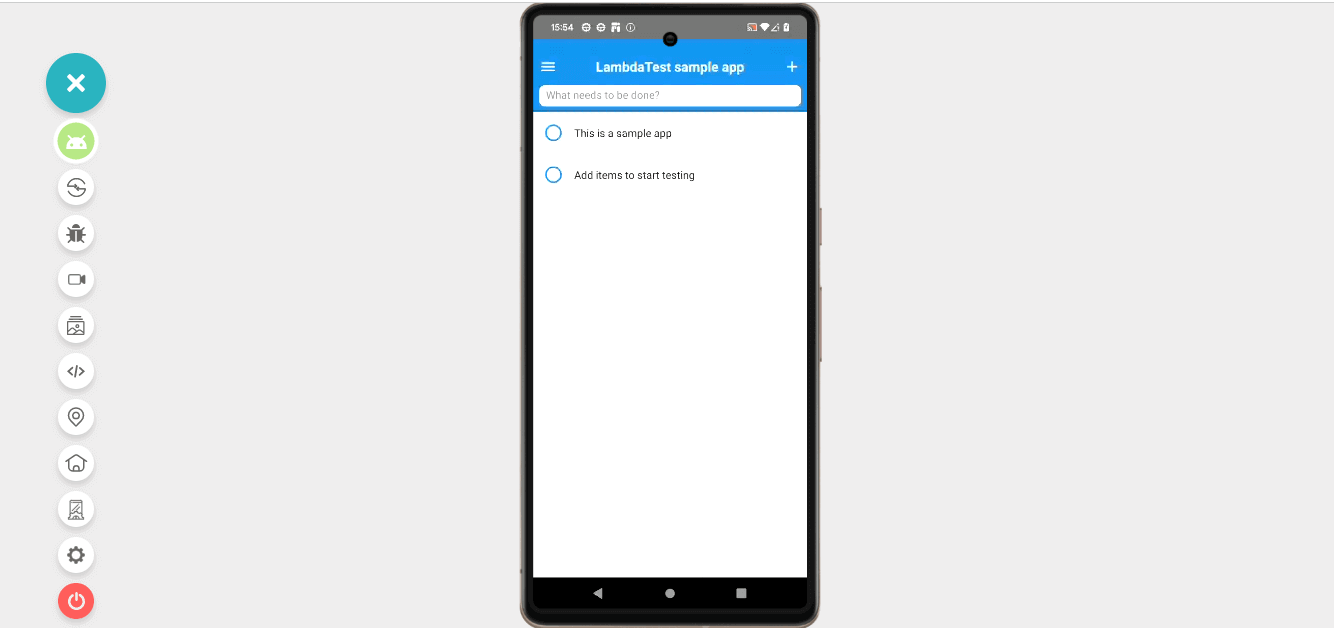
To perform real-time browser testing on real devices, please choose the Browser Testing option.
- Select Android or iOS. Enter the URL, and choose test configuration (device BRAND, DEVICE, OS, and BROWSER). Then click START.
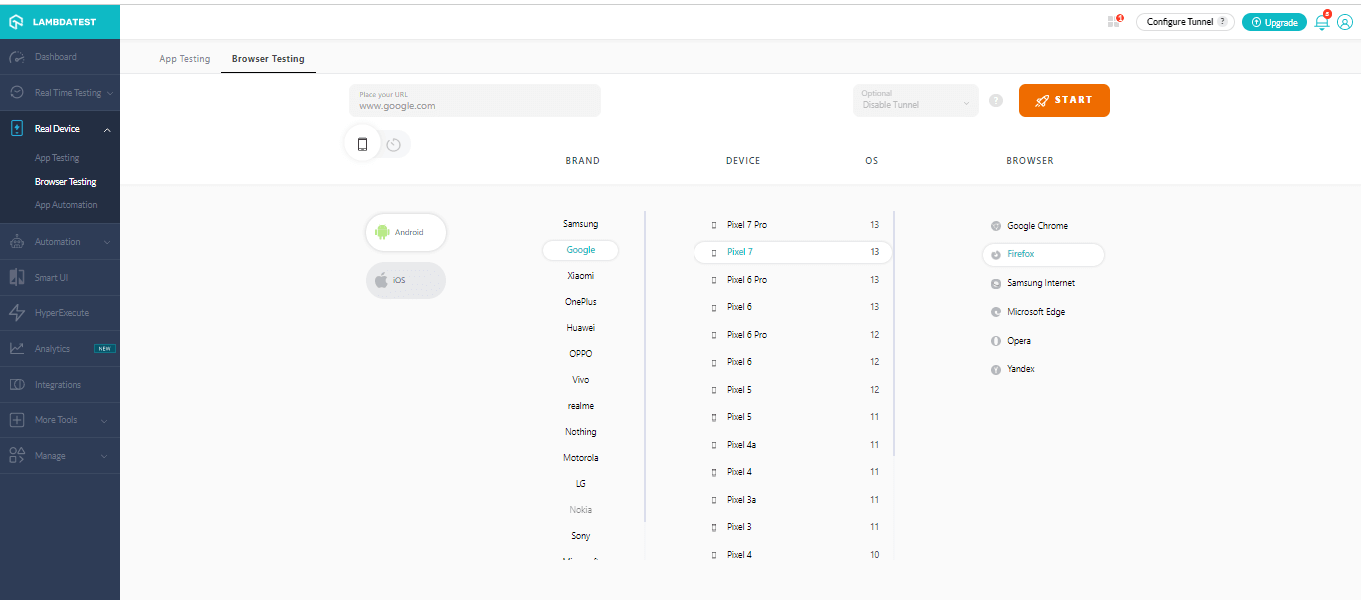
You will get a cloud-based real device launched where you can perform real time testing.
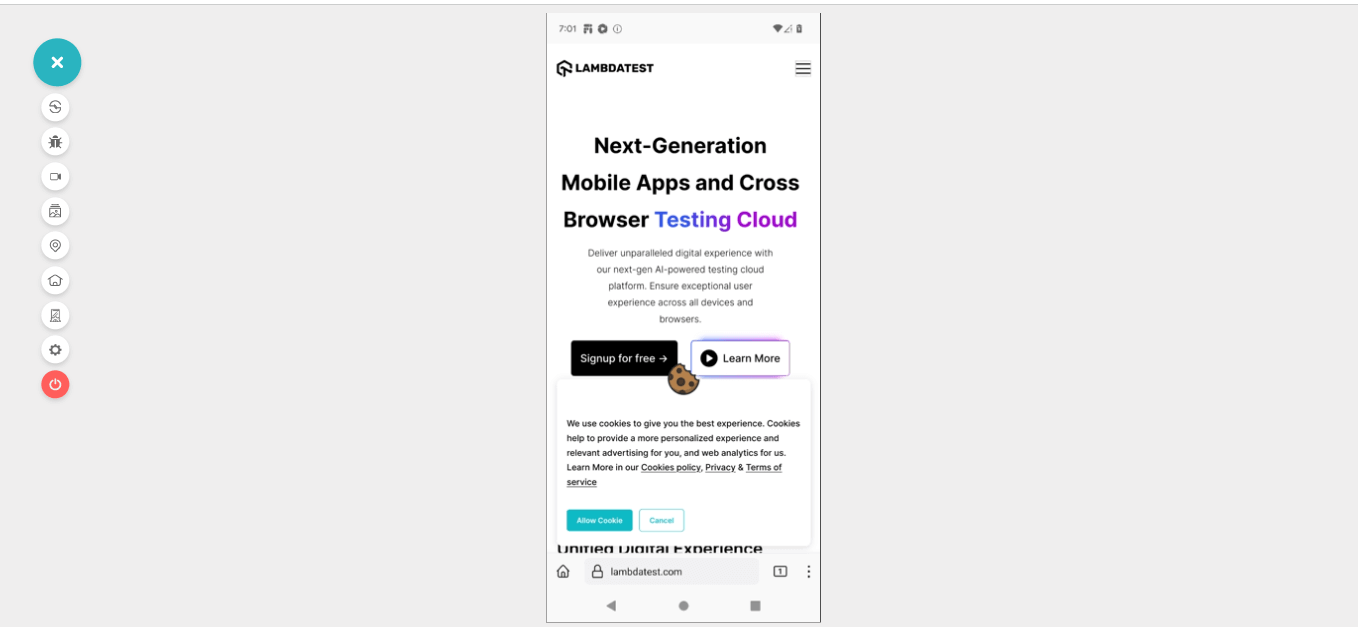
Real Time Automation Testing
LambdaTest offers you to perform automation testing over a cloud grid on 3000+ browsers, browser versions, and operating systems. Below are the steps to be followed to perform automation testing using a framework of your choice.
- Follow the same login process as mentioned above.
- Select the Automation > Builds tab on the left panel.
- Try either Demo Project or Configure Test Suite to start with automation testing.
- Select Configure Test Suite and choose your preferred automation testing framework to run a real-time automation test.
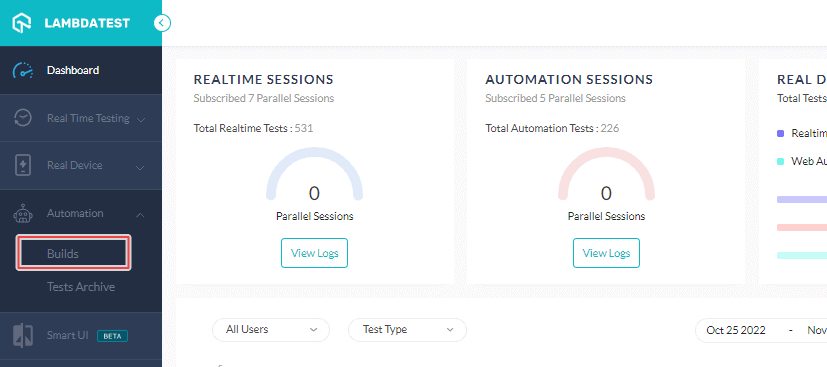
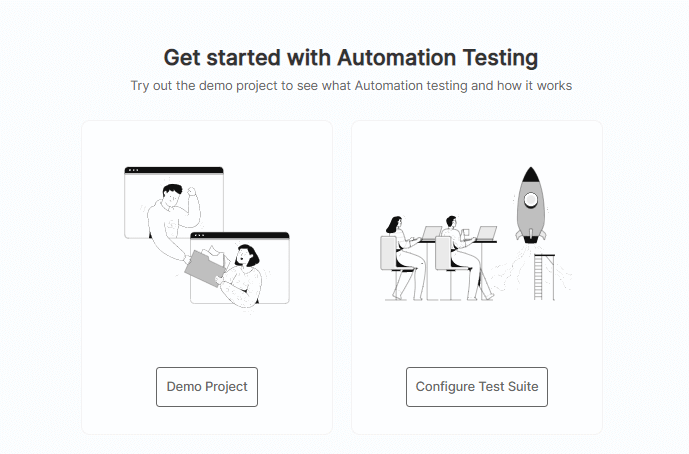
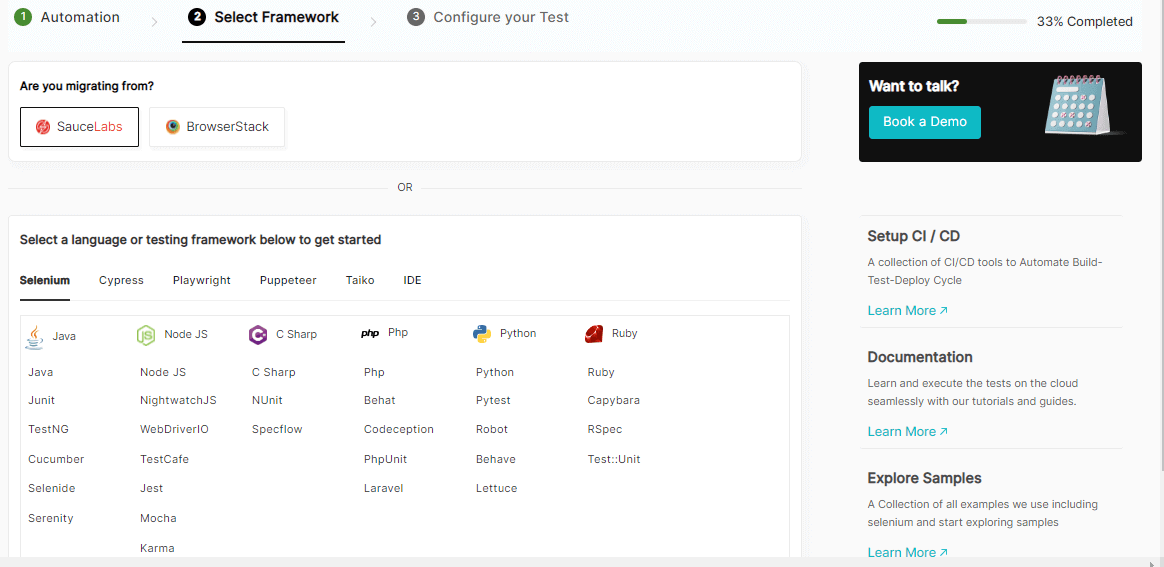
You can now configure your test and start with real-time automated testing.
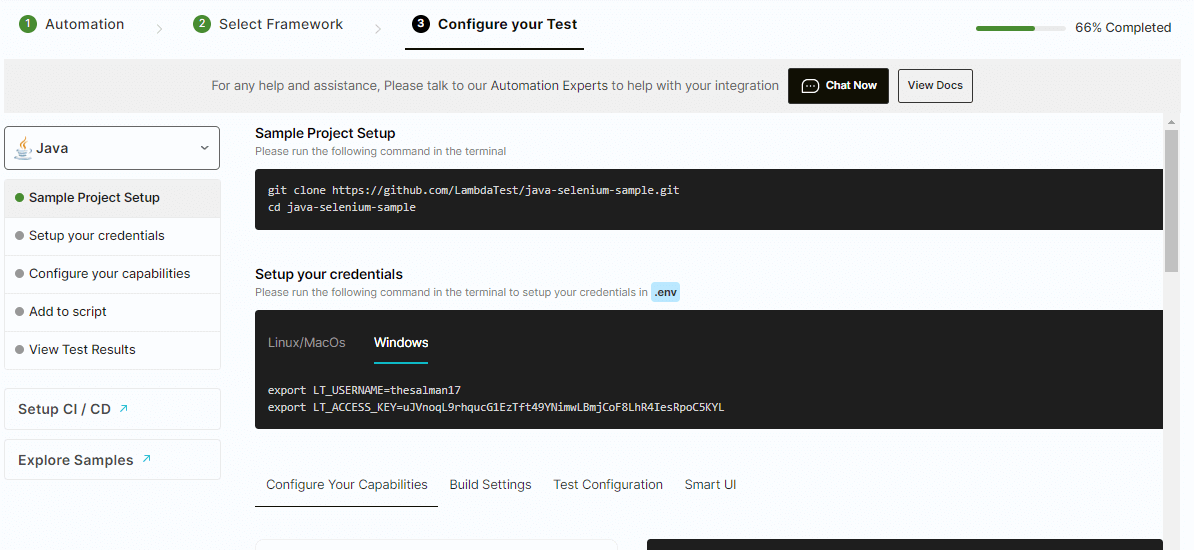
Performing automation testing in real time requires writing and running test scripts that simulate user interactions in a software application. However, it might take time for the tests to get executed depending on the scenario getting automated, especially for complex scenarios or when dealing with a large number of test cases.
However, you can further reduce the test execution time and run automated tests at the fastest possible time using HyperExecute. This blazing-fast cloud grid is up to 70% faster than the traditional cloud grid. It is a cloud-based solution that leverages multiple virtual machines in parallel to execute tests, thus reducing the overall test execution time.
Now that you understood how to perform real time testing on cloud, let’s deep dive into different aspects of real time testing including its benefits, types, techniques, and more.
Benefits of Real Time Testing
In the development of software applications, it is critical to ensure the application’s functionality is in working mode. In other words, by running tests in a real user environment, developers and testers can quickly find the issue and address them before the application is released in the market.
Testing in real-time lowers the amount of time it takes for features or functions to be tested and deployed. It allows the organization to release its software applications faster and stay competitive.
Here are some other points that describe the benefits of testing in real time:
- End-users expect software applications to respond quickly and give accurate results. With testing in real-time, you can ensure that software applications are responsive, fast, and meet end-user expectations.
- Testing in real-time lowers the software application downtime by identifying and resolving bugs before they lead to failures.
- It allows for optimizing software application performance by finding new areas or features to be improved. By analyzing the software application performance under real-world conditions, you can quickly identify bottlenecks and areas for optimization, which results in faster and more efficient software applications.
- Visual components like text, layouts, and other components are easily accessed and tested. It is easy to detect User Interfaces (UIs)/User Experience (UX) issues.
- You can perform exploratory testing or ad hoc testing of software applications in a real time approach. This test allows you to explore the software application and try different scenarios and inputs to see how it behaves.
- Testing in real-time provides a deeper level of analysis and verification of software applications. You can identify whether reported bugs are real issues and require them to be addressed.
Types of Real Time Testing
Testing in real-time involves many different types of testing, which are performed to check the quality and functionality of the software applications in real-user scenarios. Here are some of its types:
Functional Testing
In functional testing, the software application's features, workflow, and user interface are tested to ensure its functions as expected. It helps ensure the software application functions per the Software Requirement Specification (SRS). When you run a functional test, you compare each software application function to the corresponding SRS to ascertain whether its result meets the end user's expectations.
You can use manual and automated approaches to run functional tests in real-time.
Performance Testing
Performance testing is performed to check and verify the performance of the software application under different conditions like high load and stress. The main purpose is to identify performance-related issues like slow response time and determine the software applications' stability, scalability, and speed. With performance testing, you can improve the overall function and performance of the application.
Load Testing
Load testing is categorized under non-functional testing, where a QA tests the performance of the software application under a specific expected load. You can perform load testing in real time to determine how the software application function behaves while being accessed by different users simultaneously. It validates the ability of the software applications to handle a high volume of users, data, and transactions.
Stress Testing
In stress testing, software applications are tested to handle extreme conditions such as high user traffic, unexpected events, etc. In other words, by performing stress testing in real conditions, you can test the robustness of the application beyond the limits of normal operations. Hence, it prioritizes analyzing the software application to maintain robustness, error handling, and availability under heavy load rather than focusing on the behavior under normal circumstances.
Security Testing
Security testing evaluates the software application's security measures against potential threats and attacks. Such a test uncovers vulnerabilities, threats, and risks in software applications. It protects the software application from malicious attacks from intruders.
Usability Testing
Usability testing validates the software application’s ease of use and user experience. It measures how easy and user-friendly software application is by focusing on the flexibility of the application, its ability to meet its objective, and ability to navigate.
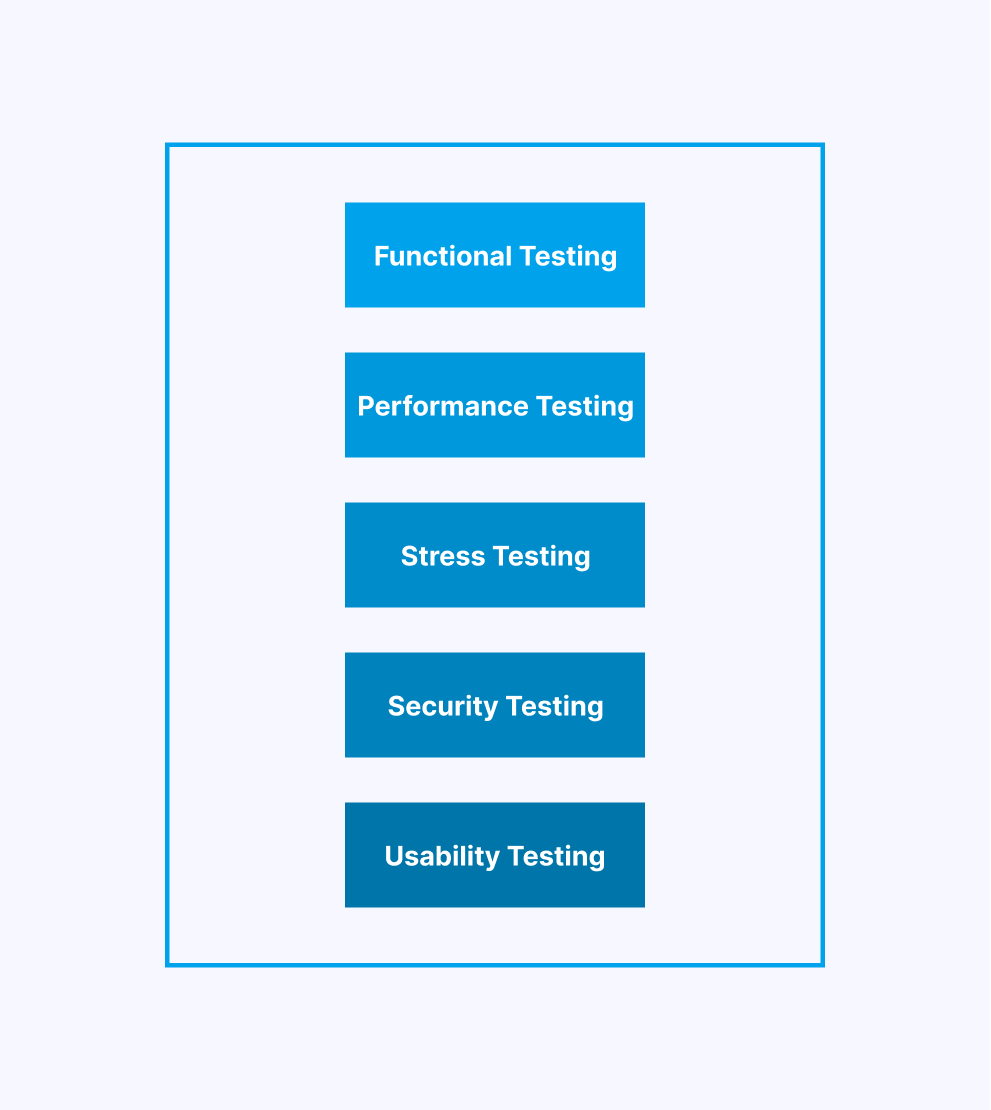
Real Time Testing Techniques
Techniques of testing in real-time are different approaches through which an application is tested against the functional and non-functional requirements of end-users. Such a test involves everything from front to back-end testing, which requires unit and system testing that encompasses real time testing. Such testing can be performed using a manual and automated approach explained below.
Manual Approach for Real Time Testing
Manual testing is the testing approach where the execution and development of test cases are done manually without using automation testing frameworks or tools. When a software application is tested in real time, some issues or bugs may interfere with its functionality. So, manual testing is performed to make the application stable and bug-free. Testers performing manual testing test the software application from the end-user perspective to develop accurate test cases and give relevant feedback to the developers for timely fixes.
Manual testing in real-time is an approach to testing the functionality of software applications. It allows the team to identify software application issues that automation testing might not detect. With this, it helps to provide crucial feedback on the usability and functionality of the software applications being tested in real time. Based on the feedback, developers fix the issues and ensure the software quality.
Manual testing is particularly important in areas like user experience and exploratory testing performed in real time. This test requires human intervention to make testing flexible and customized as per software application requirements. Testers can modify test cases on-the-fly as they observe the application's behavior. They can also test specific scenarios that automated tests may not cover.
Automated Approach for Real Time Testing
Automated testing in real-time is the crucial approach to ensure consistent and reliable results. It uses test tools or frameworks to execute pre-scripted tests on a software application before releasing it into production. Each tool and framework is scripted with rules of automation related to the software to be tested. Such frameworks and tools are integrated with components like function libraries, test data sources, object details, and other reusable modules.
Choosing the right automation testing tools for real time testing is crucial, which could optimize the testing process and deliver high-functionality applications with low maintenance costs. Automation testing in real-time is important as it reduces human error and improves the efficiency of the testing process. Automated tests can be conducted much faster than manual tests, enabling testers to uncover more errors in less time.
To automate tests effectively, it is essential to consider which tests require automation and which tools are available to support automation efforts. Certain types of tests, like real time testing, are better suited for automation than others; it provides a level of standardization that can be challenging to achieve with manual testing. Various tools like Selenium, Cypress, Playwright, and Appium exist to aid automation efforts in real time testing.
Levels of Real Time Testing
Real time testing is an integral part of the Software Development Life Cycle. It ensures that software applications developed are reliable, high-performing, and meet the needs of the end-users.
The process of testing in real-time involves five levels of testing as it forms the foundation of the entire software application, which includes the following:
Unit Testing
Unit testing is the process of testing the individual units of the source code in a software application. This type of testing focuses on examining the operational capability of the software's individual components. Frequently, developers employ this testing method to uncover defects during the initial stages of software development in real time.
A unit test case would be as fundamental as clicking a button on a web page and verifying whether it performs the desired operation. For example, you are ensuring that a share button on a webpage lets you share the correct page link.
Integration Testing
After the unit testing process, the following stage is integration testing, which involves testing multiple units as a whole. This can be explained through the example of verifying the interoperability of a sequence of web pages in a specific order.
This approach evaluates how various software application components operate collectively to achieve the intended outcome. Performing integration testing simultaneously with the development process empowers developers to identify and locate glitches in real time promptly.
System Testing
System testing is a comprehensive process examining all the software's integrated modules as a single entity. As the name implies, it validates whether the software applications meet the desired requirements.
This type of testing involves conducting various tests, such as verifying the output based on specific inputs, evaluating the user experience, and more. Depending on the team's availability of resources and time, multiple types of system testing are performed, including regression testing, stress testing, functional testing, and more.
UI Testing
UI testing validates features of any software application a user interacts with in real time. Its typical objective is to verify the visual component to check that they function in line with the functionality and performance requirements. UI testing encompasses an extensive spectrum of visual cues and graphics-based icons, which include toolbars, fonts, menus, text boxes, radio buttons, checkboxes, colors, and many more. The ultimate objective is to ensure that the UI functions are devoid of errors and function as anticipated.
Acceptance Testing
Acceptance testing is a crucial process that determines the suitability of software applications for real-world use. This type of testing occurs internally and externally, with the internal being carried out by members of the organization, commonly referred to as alpha testing, and the external being conducted by a limited number of end-users, also known as beta testing. Through this approach, teams can assess the degree to which software applications satisfy user standards and pinpoint any issues before their release in operational mode.
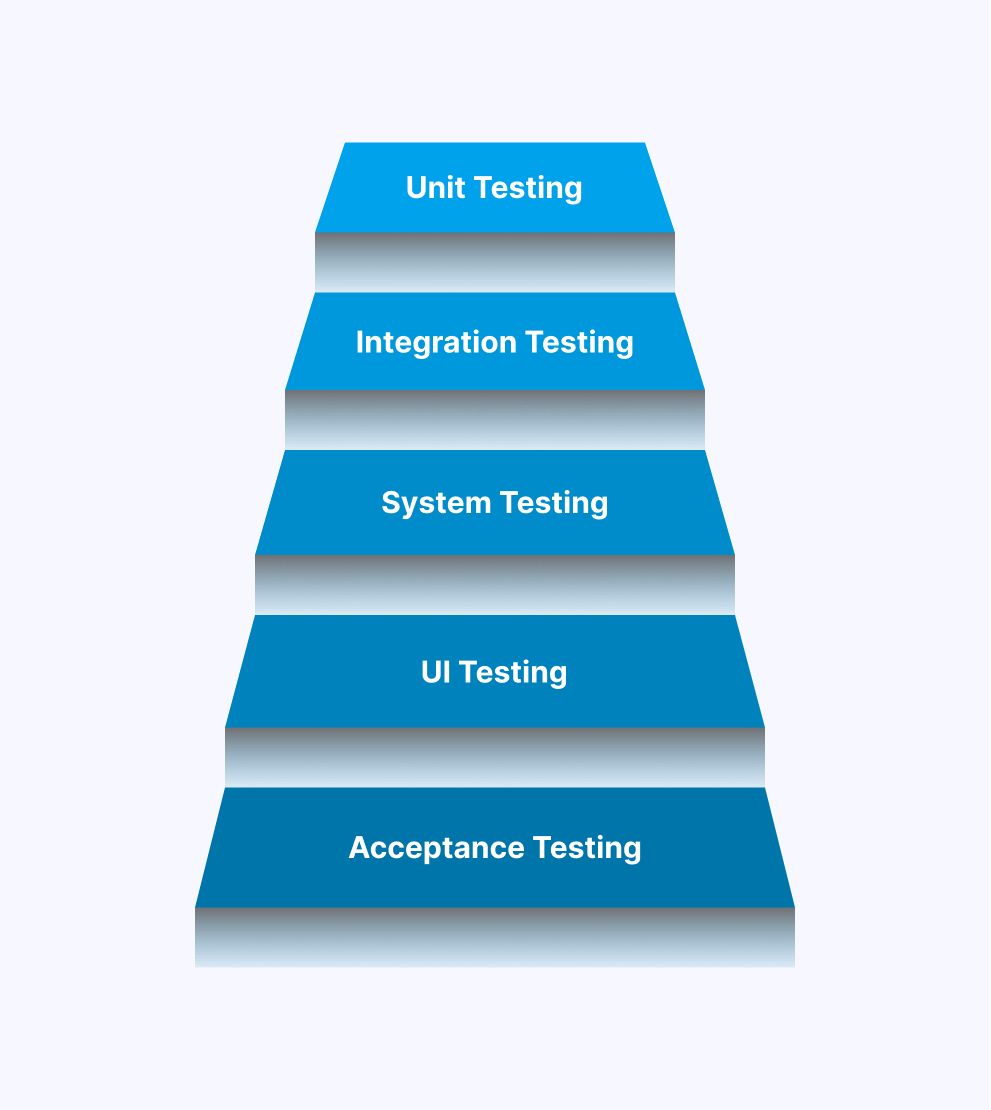
Strategies for Optimizing Real Time Testing
Teams need to optimize their real time testing to ensure that software applications or systems are free of defects and issues. There are several strategies that developers and teams can use to achieve this goal.
- One such strategy is risk-based testing, where test scenarios are prioritized based on the risk associated with their failure. This approach enables teams to focus on critical scenarios and software applications.
- Test automation is another effective strategy for optimizing testing efforts. Automation testing tools can reduce manual effort and increase consistency in testing by executing repetitive test cases more efficiently. Automated testing enables teams to run tests more frequently, leading to faster feedback and bug fixing.
- Integrating testing into the development process is crucial for identifying issues early on. By including testing activities throughout the Software Development Life Cycle, teams can unearth issues before they become significant errors and reduce overall costs.
- Continuous testing involves running tests continuously throughout the development process to identify issues as they occur rather than waiting until the end of the Software Development Life Cycle. This approach ensures that code changes refrain from introducing new defects.
- Data analytics can provide insights into testing trends and identify potential areas for improvement. Teams can analyze test results using data analytics tools to optimize their testing efforts over time.
Adopting these strategies in tandem with one another or individually as needed will lead to high-quality software applications without minimal defects or no issues while ensuring efficient usage of resources by the team involved in its development.
Real Time Testing Metrics
Real-time QA or testing metrics are crucial to ensure the software application's reliability and performance. When you perform testing in real time, the QA metrics provide insights into the behavior and functionality of the software application in real time. Using such information, it is easy for the developers and testers to quickly identify and resolve any performance-related issues.
Some of the real time metrics and their significance in testing software applications are explained below:
- Response time
- Throughput
- Error rate
- Availability
- Utilization
- Latency
This metric measures the software application's speed in responding to requests or queries. When you monitor the response time in real time, it is easy to identify issues that delay the response time of the software application. Based on this, you can take relevant action to fix the issue in the software applications.
It measures the data or transactions a system processes within a specific period. This metric is important for high-performance software applications that efficiently handle large amounts of data. By monitoring throughput in real-time, developers can identify bottlenecks that may hinder performance and ensure optimal processing speed.
The error rate measures the number of errors or failed transactions within a software application. Monitoring error rates in real-time help detect errors and performance issues needing immediate attention. It enables developers to prevent further damage to the software application while ensuring a smooth user experience by promptly identifying and resolving errors.
It measures how often a software application remains available for use without interruption or downtime. This metric is especially significant for software applications requiring continuous availability, such as online banking or eCommerce platforms. By monitoring availability in real-time, developers can promptly address issues causing downtime and ensure uninterrupted access for users round-the-clock.
Monitoring resource utilization helps identify performance issues while optimizing resource allocation efficiently. It measures resource usage percentages such as CPU or memory utilization by a software application at any moment. By allocating resources effectively, developers can improve overall software application performance while preventing resource-related problems.
Latency refers to the time taken for data transmission from one point to another within a given software application. By monitoring latency in real-time, developers can detect and resolve issues that may cause delays in data transmission, ensuring optimal system performance as expected.
Testing teams need to track these metrics to identify areas for improvement, evaluate their testing process's effectiveness and efficiency, and make data-driven decisions to optimize their testing efforts. For example, measuring response time helps identify areas where delays can cause user frustration or lead to application failure. Measuring throughput helps evaluate how efficiently an application processes large volumes of data. Measuring availability helps ensure an application is always available and responsive when needed.
By using these metrics effectively, testing teams can ensure that software applications are reliable, efficient, and meet end-user expectations while avoiding any errors or defects in their system's functionality, ensuring high-quality performance at all times.
Tools for Real Time Testing
Testing in real-time can be done using automation testing tools, which not only quickens the testing process but also ensures the software application's quality. Several tools are available for testing in real time; however, the choice depends on their features and the specific requirement of the software application.
Examples of some most popular tools and platforms for real time testing are explained below:
LambdaTest
LambdaTest is a digital experience testing platform that operates in the cloud, allowing developers to test their web applications (websites) and mobile applications across multiple devices and browsers simultaneously. LambdaTest stands out because it provides real-time access to over 3000 real browsers, devices, and operating systems, allowing developers to test their applications in diverse environments.
One of the major benefits of LambdaTest is its real device cloud that lets you test software applications in real-world scenarios. LambdaTest intuitive interface simplifies the setup and execution of automated test cases for developers. LambdaTest boasts robust and dependable testing capabilities that ensure seamless performance across various devices and browsers.
Selenium
Selenium is an open-source automation framework that allows web application testing in real time. It comprises suites of tools like Selenium IDE, Selenium WebDriver, and Selenium Grid. Selenium is popular among developers as it supports multiple programming languages like Java, JavaScript, C#, Python, and Perl. Also, it allows web application testing across various browsers like Chrome, Firefox, Edge, etc.
Playwright
Playwright is another popular automation testing tool gaining popularity among developers due to its cross browser testing capabilities, which allow them to simulate user interactions with their application across multiple browsers and devices seamlessly. Playwright also provides a powerful debugger that enables easy tracking of error sources when they occur during application development or maintenance.
Cypress
Cypress is an open-source and end-to-end automation testing framework devised to facilitate and streamline the real time testing process for web applications. Cypress creates custom commands that enable developers to quickly create automated test cases while providing an interactive GUI to run real-time tests.
It gives an intuitive user interface that helps the testers to create, run and debug the real-time test. Further, you can also perform live reloading, where you can see the outcome of the changes in the software application in real time.
Appium
Appium is a popular tool for mobile app testing on Android, iOS, and Windows platforms. It uses WebDriver protocol to test the mobile application, which eases the writing of automated test scripts. It also has a powerful API for interacting with mobile applications, and with this, you can automate the real-time test utilizing any programming language.
Note : Test your Selenium scripts on the cloud. Try LambdaTest Now!
Steps to Perform Real Time Testing
Testing in real-time ensures an application or system performs as expected under normal and peak load conditions. However, it is a multifaceted and challenging task that requires thorough planning and implementation. The process of testing in real-time includes evaluating the functionality, performance, reliability, and user experience of the application or system in real-world scenarios.
Below are the steps to perform testing in real-time:
- Identifying critical scenarios and designing test cases: The first step in conducting real time testing involves identifying critical scenarios that need to be tested and creating test cases to evaluate these scenarios. It entails scrutinizing the requirements of the application or system and recognizing key performance criteria.
- Setting up the necessary infrastructure and tools: Once test cases have been designed, it is necessary to set up the required infrastructure and tools to support testing. It may involve configuring test equipment, establishing data collection and analysis protocols, and creating test environments.
- Executing tests and monitoring for issues: With all necessary infrastructure in place, the testing team can begin executing tests while monitoring for issues in real-time. This test requires simulating actual events/scenarios so that they can ascertain if the application or system functions as intended.
- Troubleshooting and detecting issues: During testing, issues are bound to arise; hence it's paramount for the team conducting tests to be able to troubleshoot and detect these issues immediately after they occur using their technical expertise, analytical skills, alongside problem-solving abilities.
- Documenting and reporting on test results: As each test case progresses, it's important to document results from each test cycle must be documented accurately. Such a document should have all observations recorded along with any defects noticed, while recommendations made on how best improvement can be achieved.
- Iterating and refining testing strategies: Based on feedback from each cycle of tests conducted by the team, they will need to refine their strategies continuously so that optimal performance can always be achieved through improved efficiency and quality user experience.
Challenges in Real Time Testing
Testing in real-time can be difficult as it involves some challenges in its execution. It is essential to consider those challenges to perform real time testing accurately. Here are some challenges in real time testing which all developers and testers should consider.
- Security: Testing software applications in real-time often deal with sensitive data that must be protected from unauthorized access or breaches. Implementing strong encryption and access controls are essential measures that must be taken in this regard.
- Scalability: It is the crucial factor that needs attention when testing software apps in real time. These applications must handle increasing user traffic and data volumes without affecting performance, making scaling more complex than traditional applications.
- Dealing with network latency and connectivity issues: Since the software applications rely on real time communication between multiple devices or systems, any delay or interruption in the network can cause the application to malfunction or fail.
- Compatibility: Compatibility across different platforms, devices, and operating systems is important when testing real time applications. Ensuring compatibility across all these platforms can prove challenging at times.
Thus, quick and accurate feedback is necessary for testing in real-time since these applications must provide users with immediate feedback. Testing must be performed quickly and efficiently without any delays or performance issues.
Troubleshooting Tips for Real Time Testing
Real-time issue identification and resolution can be daunting, but some tried-and-true troubleshooting techniques can help teams tackle these challenges. Here are some of those:
- One crucial step is to set up proper alerts and notifications in advance, so you can be alerted as soon as an issue occurs. It allows you to identify and address issues before they escalate swiftly. Further, reviewing system logs provides insight into what happened and how to fix the errors or issues.
- Communication is key when it comes to troubleshooting real-time issues. It's significant to collaborate and work with developers and other team members to identify the root cause of the issues and develop a plan for fixing them. Brainstorming sessions, troubleshooting calls, or even pair programming can be helpful in this regard.
- Real-time analytics offer valuable insights into software applications performance and user behavior. Identifying patterns and trends in this data may give clues about what's causing an issue. For example, if there's a spike in user traffic at a specific time of day, this could point toward the root cause of the issues.
- Regular maintenance tasks such as updating software, patching security vulnerabilities, and optimizing system resources are crucial for running software applications smoothly. By staying on top of these tasks, you can reduce the likelihood of issues occurring in the first place.
- Creating a testing environment that mimics production conditions helps minimize the impact of issues during testing in real-time. It enables you to identify and fix problems before they occur in live environments.
- User experience monitoring during real time testing involves tracking response times, error rates, and other metrics that impact user experience. By monitoring these metrics closely, you can identify potential issues before they affect users.
Best Practices of Real Time Testing
Testing in real-time is a critical process that involves testing software applications in real-world scenarios to identify any potential issues that may arise during actual usage. This method is essential for ensuring the reliability and quality of software applications as it allows developers and testers to detect and fix problems before they affect end-users. To achieve optimal results in real time testing, it is crucial to follow some best practices.
- One of the most important best practices is identifying critical scenarios and designing test cases that test these scenarios. It means understanding user behavior and identifying situations that most likely occur during actual usage. By testing these scenarios, you can ensure that your testing is relevant and focused on the most crucial aspects of the application.
- Another best practice is performing continuous testing throughout development, starting from the early stages. It allows you to detect issues or bugs early on and fix them before they become more critical, reducing the overall time and cost required for testing.
- Test automation can also help reduce errors while increasing efficiency by automating repetitive tasks freeing up resources for more critical aspects of testing. Integrating testing into the development process ensures catching issues before they worsen while meeting required standards, ultimately reducing the overall time and cost needed for extensive quality assurance.
- Establishing clear metrics helps measure success while identifying areas for improvement by defining metrics; you can evaluate how effective your tests are in achieving desired outcomes while delivering high-quality software applications.
Conclusion
In this guide, you have come across various crucial related concepts of real time testing, which will help you gain insight and information to get started. Let's summarize the learnings. Testing in real-time is an essential aspect of software development that ensures the reliability and accuracy of software applications. It involves testing the system's responsiveness and performance in real-time scenarios to identify any issues that may arise during usage. In this regard, following some best practices that can help achieve optimal results is essential.
Implementing this guide's best practices and tips will help you conduct effective real-time tests on your software application. By doing so, you can minimize risks of defects, improve user experience and enhance the overall success of your application by ensuring its reliability, functionality, and optimal performance under realistic conditions.
You can effectively use real-time test metrics like throughput, response time, etc. Using these metrics, teams can ensure that real time applications are reliable, efficient, and meet end-user expectations while avoiding any errors or defects in their system's functionality, ensuring high-quality performance at all times.
Frequently asked questions
- General
Did you find this page helpful?
Author's Profile

Nazneen Ahmad
Nazneen Ahmad is an experienced technical writer with over five years of experience in the software development and testing field. As a freelancer, she has worked on various projects to create technical documentation, user manuals, training materials, and other SEO-optimized content in various domains, including IT, healthcare, finance, and education. You can also follow her on Twitter.
Reviewer's Profile

Salman Khan
Salman works as a Digital Marketing Manager at LambdaTest. With over four years in the software testing domain, he brings a wealth of experience to his role of reviewing blogs, learning hubs, product updates, and documentation write-ups. Holding a Master's degree (M.Tech) in Computer Science, Salman's expertise extends to various areas including web development, software testing (including automation testing and mobile app testing), CSS, and more.
More Hubs
Try LambdaTest Now !!
Get 100 minutes of automation test minutes FREE!!

 Christmas Deal is on: Save 25% off on select annual plans for 1st year.
Christmas Deal is on: Save 25% off on select annual plans for 1st year.

